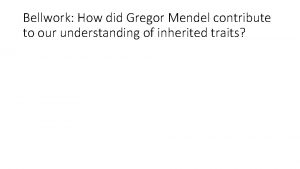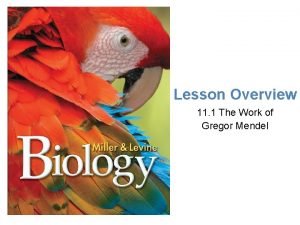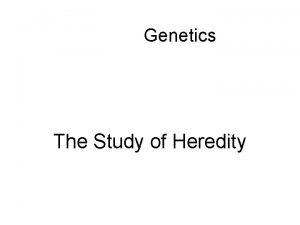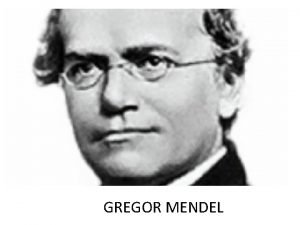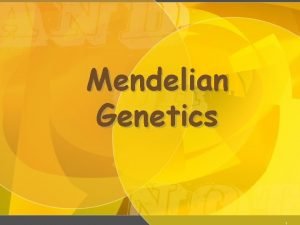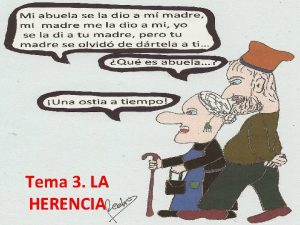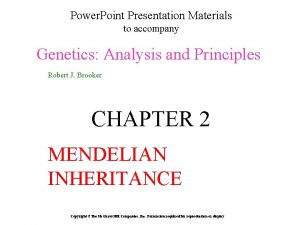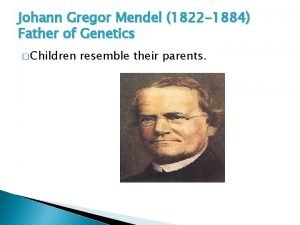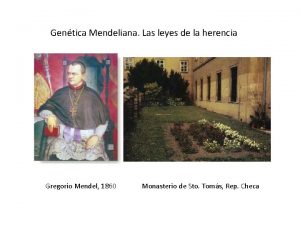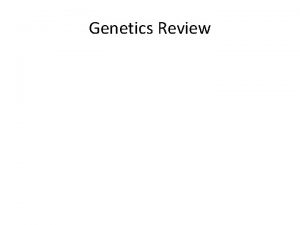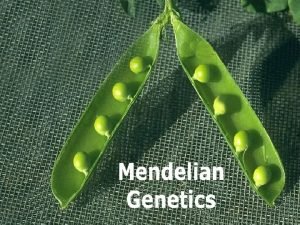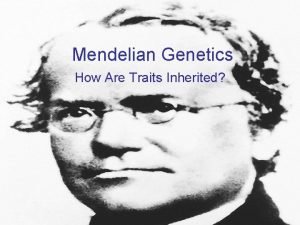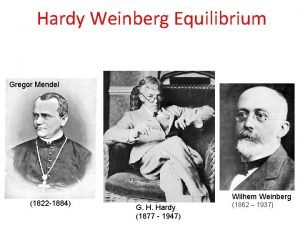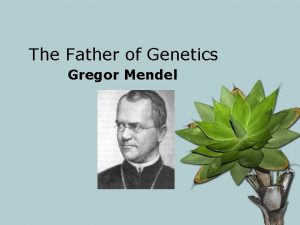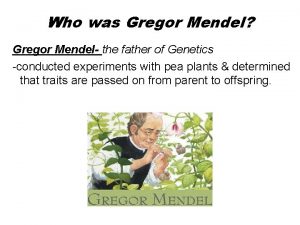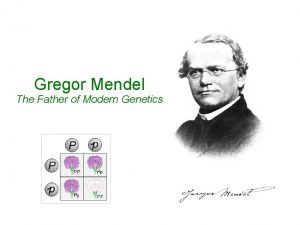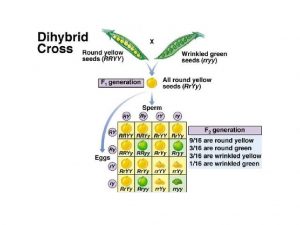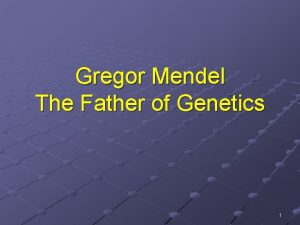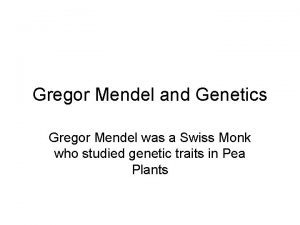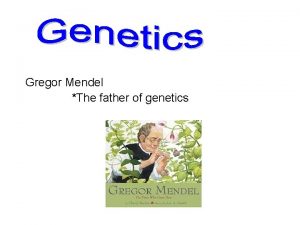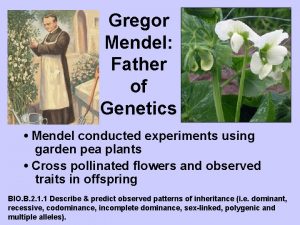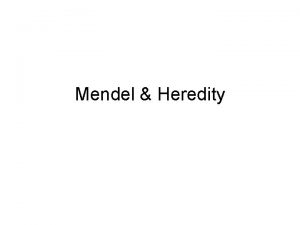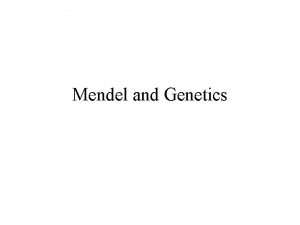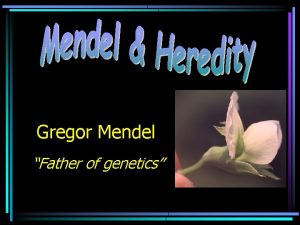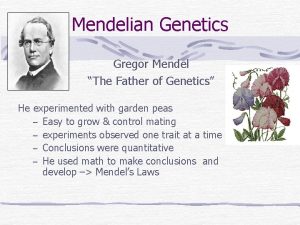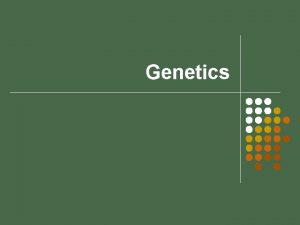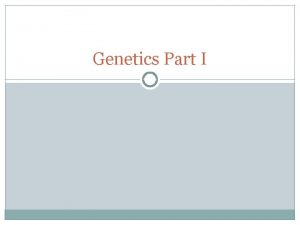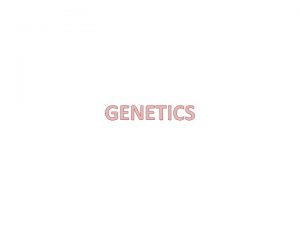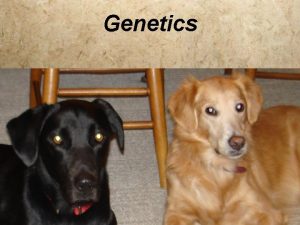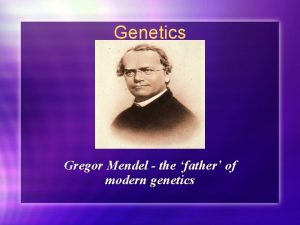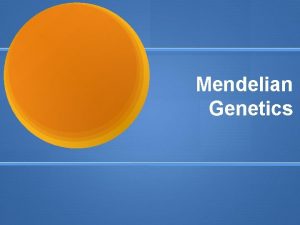Mendel Genetics l Gregor Mendel Father of genetics
























- Slides: 24

Mendel & Genetics l. Gregor Mendel – “Father of genetics”

Define Heredity. l. The passing on of traits from one generation to the next.

Where is genetic information stored? l. DNA Chromosomes - structures containing many genes made up of DNA

What did Mendel study to understand inheritance? l Common garden pea plants l Why did he choose pea plants? l 1 --Fast growing with many offspring = quick results l 2—Reproduce sexually l 3—Traits come in two forms. ¡Like tall and short or green and yellow

What did Mendel call true breeding? l. Plants that show the same trait (Pure) l. When he crossed two true-breeding plants with opposite traits, he called this what? l. The “P” cross for Parental generation

What two individuals did Mendel cross in the P generation? l. True-breeding Tall and Short pea plants l. Genotypes? l. Tall = TT l. Short = tt

What resulted in the F 1 generation? l. Pea plants that were… l. Phenotypes l. All TALL Genotype ¡All “Tt”

What was Mendel’s next step? l. He crossed two F 1 plants. l. What results did he get? l. The F 2 generation l. What ratio did he find? l. They were 3: 1 (dominant to recessive)

The Law of Segregation l 1 --Individuals have two copies of genetic information for every trait (alleles)– one from each parent l 2—each copy is passed randomly l 3—One of these alleles can mask the expression of the other (Dominant can mask recessive when both are present)

The Law of Independent Assortment l Alleles of different genes separate independently of one another during gamete formation l What does that mean? l The allele a parent gives for one trait does not affect what he/she gives for another trait so you can have many different combinations of traits

What are alleles? l. Different forms of the same gene for a trait l. When an individual has two of the same allele, the genotype is called…Homozygous l. When there are two different alleles, it is… Heterozygous

What is the difference between genotype and phenotype? l. Genotype is lthe type of genes or alleles l. Phenotype is l. What is looks like--The physical appearance of the organism

Monohybrid vs. Dihybrid l. Monohybrid: a cross when there is just one trait involved. l. Dihybrid: Two traits are involved

Contrast a Punnett Square and a Pedigree l A Punnett Square is… l a grid that predicts the types of possible offspring from a cross l A Pedigree is. . l A diagram that shows a family tree and how traits pass from generation to generation

Modes of Dominance: l 1 --Complete dominance… l One allele is completely dominant over the recessive and the recessive is masked in a heterozygous individual l 2 --Incomplete dominance. . l The dominant does not completely mask the recessive and the heterozygous phenotype is a blend of the two- an intermediate variation. l There are three possible phenotypes.

More modes of inheritance l 3 -- Codominance. . l More than one allele is dominant and when two of these are together, they form another phenotype l 4– Multiple alleles. . l Traits having 3 or more alleles l Example of both Codominance and Multiple alleles. . Blood types. l How many blood types are possible? l Four-- They are…A, B, AB, and O

Information about Blood Type Crosses l Phenotypes Genotypes ¡Type A AA(pure) or AO(hybrid) ¡Type B BB (pure) or BO (Hybrid) ¡Type AB AB (Codominant) ¡Type O OO (recessive) *Although there are 3 alleles—the offspring only gets 2—One from each parent* A is Dominant B is Dominant O is recessive to A & B

Modes of Inheritance cont. l 5 -- Polygenic Inheritance: traits that are controlled by multiple genes pairs. l This makes many variations of color and trait possible l What are characteristics controlled by multiple pairs of alleles? l Human hair and eye color

Sex-linked Inheritance l Autosomes - all chromosomes except the. . X or Y chromosomes l Sex-linked characteristics are always on… l The X-chromosome l Examples of a sex-linked condition: l Hemophilia, Color-blindness, Baldness l Sex-linked traits are recessive l Why does it occur more in males? l Males only inherit 1 X-chromosome so there is a better chance they would express the condition.

Pedigree Chart l. A diagram that shows a family tree and how traits pass from generation to generation

How to use a Pedigree Chart Squares are used to indicate Males Circles are used to indicate females If the individual is “affected” by the traits, the symbol is darkened. If individual is “not affected”, symbol is clear A line between male and female indicated a marriage A line drawn down from the marriage indicated offspring


Hints for analyzing pedigrees l 1) If the individual is homozygous recessive (both lower case letters), then both parents MUST have at least one recessive allele l 2) If the individual has the dominant trait, then at least one parent MUST have the dominant allele.

l Label the Homozygous recessive individual first (lower case letters) l Trace the recessive alleles back to the parents l Label the parents with the dominant allele (Capital letter) ¡*If you’re not sure what the other letter might be, leave it blank* l Compare the other offspring to see which allele they also inherited
 Gregor mendel a monk
Gregor mendel a monk Chapter 11 biology test
Chapter 11 biology test How did gregor mendel contribute to genetics
How did gregor mendel contribute to genetics Wo ist bach geboren
Wo ist bach geboren Gregor mendel
Gregor mendel Y chromosome traits
Y chromosome traits Gregor mendel
Gregor mendel Gregor mendel
Gregor mendel Section 11-1 the work of gregor mendel
Section 11-1 the work of gregor mendel Gregor mendel plant
Gregor mendel plant Austrian monk
Austrian monk Cromosomas homologos alelos
Cromosomas homologos alelos Gregor mendel laws
Gregor mendel laws Chapter 12 lesson 1 the work of gregor mendel
Chapter 12 lesson 1 the work of gregor mendel Gregor mendel
Gregor mendel Mendel's law of independent assortment and segregation
Mendel's law of independent assortment and segregation Gregor mendel herencia
Gregor mendel herencia How many pairs of chromosomes do humans have? *
How many pairs of chromosomes do humans have? * Mendel genetics
Mendel genetics Blank is the austrian monk who experimented with blank
Blank is the austrian monk who experimented with blank Who was gregor mendel
Who was gregor mendel Gregor mendel
Gregor mendel Gregor mendel
Gregor mendel Suit separate
Suit separate Mendel equilibrium
Mendel equilibrium


